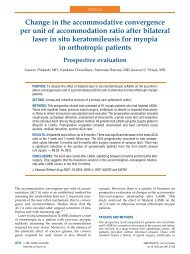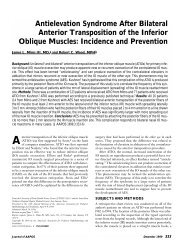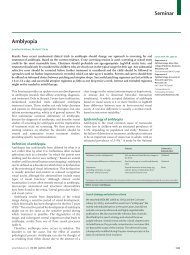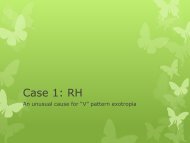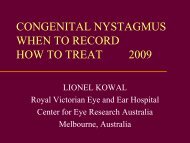What's new AAPOS 2008 - The Private Eye Clinic
What's new AAPOS 2008 - The Private Eye Clinic
What's new AAPOS 2008 - The Private Eye Clinic
You also want an ePaper? Increase the reach of your titles
YUMPU automatically turns print PDFs into web optimized ePapers that Google loves.
<strong>Clinic</strong>al expression of Leber hereditary optic neuropathy is affected by the<br />
mitochondrial DNA – Haplogroup background.<br />
Hudson G, Carelli V, Spruijt L, Gerards M, et al.<br />
Am. J. Hum. Genet 2007; 81:228-233.<br />
<strong>The</strong> author present 2 alternative: 1) to use an LCA diagnosis only in patients in whom<br />
there are absolutely no other signs of systemic or neurological abnormalities, and to<br />
assign all others to the respective syndromes; or 2)change the terminology from LCA to<br />
LCAOP (LCA ocular phenotype) to include initially all patients with this blinding ocular<br />
condition, with the understanding that the diagnosis could be changed to LCA or that of<br />
a more specific systemic one as other manifestations of the disease become more<br />
manifest.<br />
Novel compound heterozygous TULP1 mutations in a family with severe earlyonset<br />
retinitis pigmentosa.<br />
Anneke den Hollander PhD, Janneke van Lith-Verhoeven MD, Maarten Arends BSc,<br />
Tim Strom MD PhD, Frans Cremers PhD, Carel Hoyng MD PhD<br />
Arch Ophthalmol 2007;125(7):932-935<br />
This study confirms that TULP1 mutations cause a severe early-onset form of<br />
autosomal recessive retinitis pigmentosa. Members of a Surinamese family with<br />
autosomal recessive retinitis pigmentosa underwent blood sampling and ophthalmologic<br />
examinations. All affected family members had a severe retinal dystrophy with history<br />
of nystagmus, low visual acuity, and nyctalopia since infancy. <strong>The</strong> scotopic and<br />
photopic responses were nonrecordable on electroretinography. A genome-wide scan<br />
suggested linkage to the chromosomal region containing the TULP1 gene. Mutation<br />
analysis of TULP1 identified novel compound heterozygous mutations in all affected<br />
family members.<br />
Blue eye color in humans may be caused by a perfectly associated founder<br />
mutation in a regulatory element located within the HERC2 gene inhibiting OCA2<br />
expression<br />
Eiberg H, Troelsen J, Neilsen M, Mikkelsen A et al.<br />
Hum Genet <strong>2008</strong>; Jan 3 [Epub, ahead of print]<br />
Human eye color is a quantitative trait displaying multifactorial inheritance. <strong>The</strong> locus<br />
responsible for the brown or blue eye phenotypes is 15q. Subsequent studies have<br />
shown that the OCA2 locus is the major contributor to the human eye color variation.<br />
<strong>The</strong> authors’ present evidence, from linkage and association studies, that a region in<br />
HERC2 contains a highly conserved regulatory element, which is the cause of blue eye<br />
color in humans. (<strong>The</strong>y analyzed data from a three-generation Danish family. Only<br />
families with siblings, who had blue and brown eyes, were included in the study). This<br />
element had an inhibitory effect on the OCA2 promoter activity in cell cultures, and the<br />
blue and the brown alleles were shown to bind non-identical subsets of nuclear extracts.<br />
62



